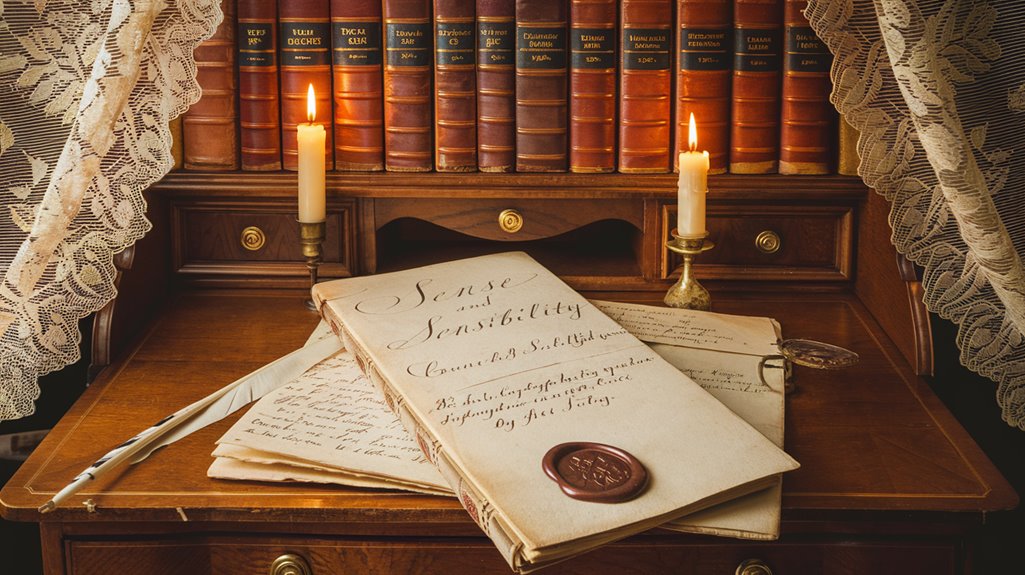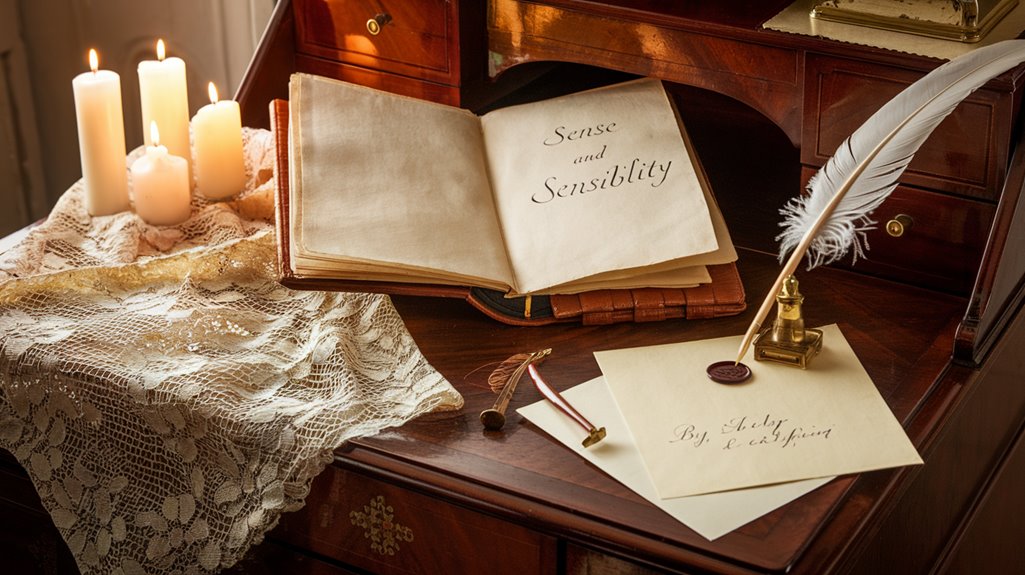Sense and Sensibility Was Initially Published as “By a Lady
You might think Jane Austen's path to publishing "Sense and Sensibility" was straightforward, but her decision to release it as "By a Lady" reveals a complex story of gender politics in Regency England. As you consider the literary landscape of 1811, you'll find that female authors often faced a challenging choice: publish anonymously or risk social criticism. Austen's strategic use of this modest attribution wasn't just about protecting her identity—it marked the beginning of a remarkable literary career that would transform women's writing forever.
The Path From Manuscript to Publication

While Jane Austen's masterpiece "Sense and Sensibility" hit bookstores in 1811, its journey began sixteen years earlier as an epistolary novel called "Elinor and Marianne." The manuscript underwent several significant transformations, starting with its conversion to narrative format in 1797 and culminating in final revisions at Chawton in 1809-1810.
During the publication journey, Austen's brother Henry connected her with publisher Thomas Egerton. The novel was released under the attribution "By a Lady" on its title page. The story's focus on two sisters with contrasting personalities would become one of Austen's most defining characteristics.
You'll find it interesting that Austen had to finance the publication herself, using her modest legacy to cover production and advertising costs. Her manuscript revisions included updating references for the Regency period and adjusting the Dashwood ladies' income to reflect contemporary standards.
After creating a clean manuscript copy, she corrected proof sheets from Egerton, though she often expressed frustration with publication delays.
Anonymous Publishing in the Early 1800s
As publishing trends evolved in early nineteenth-century England, anonymous authorship dominated the literary landscape, with up to 85% of new fiction appearing without named writers between 1750-1789.
Though this rate dropped to 40% by 1805, it rose again to nearly two-thirds in the 1830s.
You'll find that anonymity benefits were particularly important for women writers like Jane Austen, who published her works as "By a Lady" to avoid societal judgment. Her family's evening reading sessions helped refine her anonymous works before publication.
Publishing strategies often involved using general social categories or references to other novels instead of author names.
This approach helped writers secure future professional opportunities while maneuvering through the commercial demands of circulating libraries. Libraries like Thomas Lowndes' in London had 56% anonymously authored works in their fiction catalogs.
Even renowned authors like Pope, Swift, and Sterne embraced anonymous publishing, shaping how readers engaged with literature throughout the period.
Breaking Ground in Literary Techniques
Through groundbreaking literary techniques, Jane Austen revolutionized the novel form in *Sense and Sensibility*.
You'll notice her pioneering use of free indirect speech, which seamlessly blends the narrator's voice with characters' thoughts, particularly evident in Mrs. John Dashwood's inner monologues. Her intricate writing style features long formal sentences that encourage readers to deeply contemplate the characters' motivations and social commentary.
The conversations between characters reveal their unique identities through distinctive voices that reflect their individual backgrounds and moral standings.
Austen's mastery of literary devices shines through her expert use of irony to expose social hypocrisy and the marriage market's absurdities.
Her narrative techniques include carefully crafted antithesis, demonstrated in the contrasting personalities of Elinor and Marianne.
Originally written as letters, the novel's transformation into a narrative structure allowed Austen to develop deeper psychological portraits of her characters.
You'll find her precise diction, strategic use of rhetorical questions, and subtle allusions working together to create a sophisticated critique of 18th-century social norms.
Financial Risks and Rewards
Because financial stability shaped the destiny of Austen's characters, *Sense and Sensibility* masterfully portrays the high-stakes world of 19th-century wealth management.
You'll find characters grappling with complex financial decision making that could either secure their future or lead to social ruin. Elinor's rational approach to finances exemplifies the importance of careful money management. The consequences of their choices extend far beyond monetary gains or losses, directly impacting their relationships and social standing.
What makes the novel particularly relevant is its emphasis on economic awareness. You'll recognize how characters who demonstrate prudent financial management tend to fare better than those driven purely by greed. The characters' experiences mirror modern lessons about identity theft and fraud, highlighting timeless financial vulnerabilities.
When you examine the financial risks presented in the story, from inheritance disputes to potential loss of status, you'll understand why Austen's exploration of wealth management remains remarkably applicable to modern financial challenges.
Women Writers in Regency England

In literary circles, women's voices emerged through powerful narratives that explored romance, social critique, and personal experience.
Writers like Mary Shelley and Sydney Owenson challenged conventional thinking while maintaining their precarious social positions. Most successful women writers came from families that supported their education and creative pursuits, though they still faced significant economic and legal barriers. This was evident in how authors like Jane Austen published their works anonymously at first.
Their works weren't just entertainment – they were careful examinations of society's limitations on women's lives and aspirations. Many authors during this period, including Maria Edgeworth and Ann Radcliffe, were featured in notable academic resources that documented their literary contributions.
The Legacy of "By a Lady"
Anonymity shaped the early literary landscape for women writers, with "Sense and Sensibility" standing as a prime example through its publication "By a Lady" in 1811. The anonymity benefits were significant, protecting women from societal judgment while allowing their work to be evaluated on merit alone. Writers like George Eliot recognized this challenge and openly criticized trivial writing by women in her essay about lady novelists. Between 1750 and 1790, over 80 percent of novels were published without author attribution. You'll find that this practice influenced generations of writers, including George Eliot and Charlotte Brontë, who adopted male pseudonyms to navigate the literary world.
- Protected women writers from personal scandals and social criticism
- Enabled works to be judged independently of gender bias
- Created a lasting impact on publishing strategies for future generations
Even today, you can see the enduring legacy of "By a Lady" in discussions about gender and literary recognition, reminding us of the challenges women writers once faced in achieving public acknowledgment for their work.










